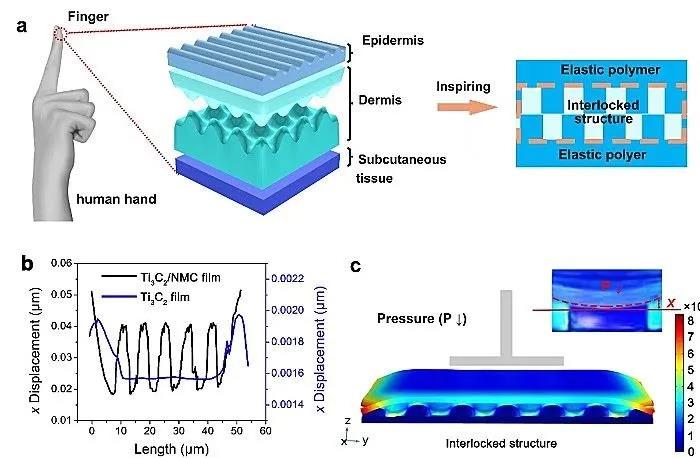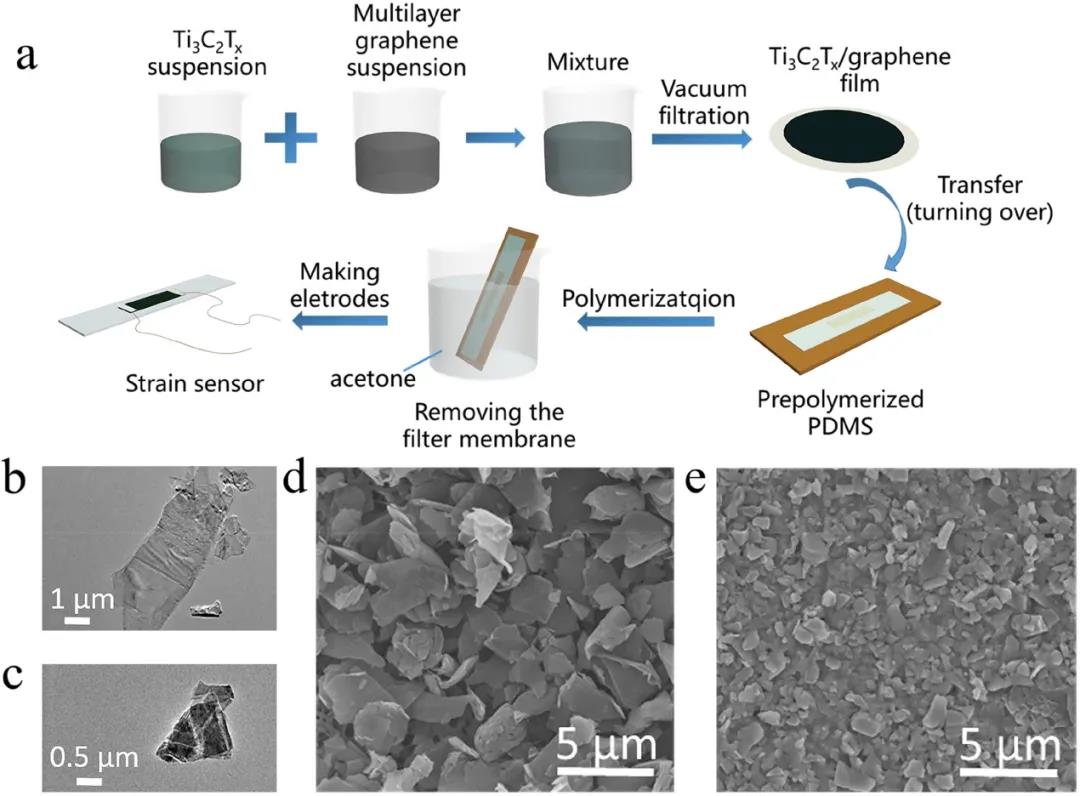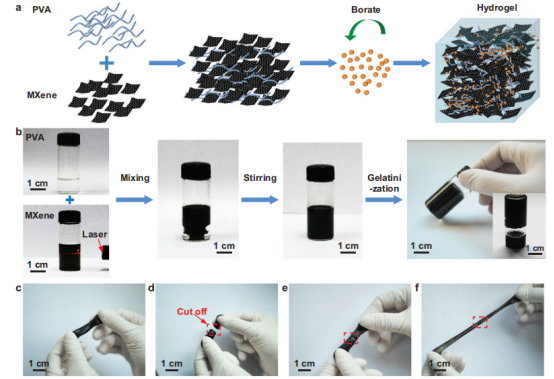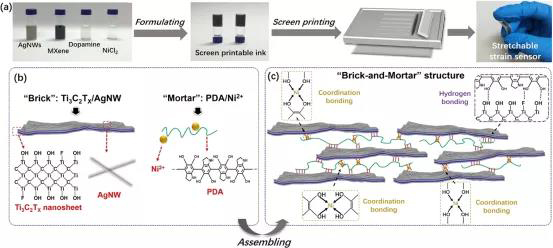
hotline:
17715390137
Tel/Wechat:
18101240246 (Technology)
0512-68565571
Email:mxenes@163.com (Sales Engineer)bkxc.bonnie@gmail.com
Scan the code to follow or search the official account on WeChat:
2D Materials Fronrier After paying attention,
click on the lower right corner to contact us,
Enter enterprise WeChat.
Professional Services Online

 MXene materials are gradually occupying a place in the field of flexible electronic sensors due to their good electrical conductivity, mechanical properties, hydrophilicity and easy morphology adjustment. In recent years, research on resistive flexible force-sensitive sensors based on MXene materials has revealed that the structure of conductive sensitive materials of MXene-based flexible strain sensors and MXene-based flexible piezoresistive sensors, as well as the analysis of sensor mechanism and sensing performance, have achieved good results. Progress. By fully considering the advantages of the MXene material and the target requirements of the device, the MXene material is combined with other suitable materials to form a new sensing system, which can maximize the synergistic effect between MXenes and other phase materials, thereby obtaining sensitivity High performance and flexible force sensor with wide response range.
MXene materials are gradually occupying a place in the field of flexible electronic sensors due to their good electrical conductivity, mechanical properties, hydrophilicity and easy morphology adjustment. In recent years, research on resistive flexible force-sensitive sensors based on MXene materials has revealed that the structure of conductive sensitive materials of MXene-based flexible strain sensors and MXene-based flexible piezoresistive sensors, as well as the analysis of sensor mechanism and sensing performance, have achieved good results. Progress. By fully considering the advantages of the MXene material and the target requirements of the device, the MXene material is combined with other suitable materials to form a new sensing system, which can maximize the synergistic effect between MXenes and other phase materials, thereby obtaining sensitivity High performance and flexible force sensor with wide response range.
1. Science Advance: MXenes pushes hydrogel sensing performance to new limits
With the rapid development of technologies such as wearable electronics, real-time detection and soft robotics, strain sensors are required to have high sensitivity, stretchability, adherence to arbitrarily complex surfaces, and preferably self-repairing. . Conductive hydrogels are considered ideal sensing materials for these applications. However, their sensitivity is generally low, and due to their viscoelasticity, they cause signal lag and fluctuations, which may affect their sensing performance. Researchers at King Abdullah University of Science and Technology have developed a conductive hydrogel "MXenes stretch hydrogel sensor performance to new limits" and published it on the international journal Science Advance. It makes the e-skins stretch ability, self-healing ability and The strain sensitivity has reached a new limit. This is a hydrogel composite material mixed with MXene (Ti3C2Tx). The sensing performance of this hydrogel is better than that of previously reported hydrogel strain sensors. The resulting composite hydrogel (MXene hydrogel (M-hydrogel)) shows excellent tensile strain sensitivity with a measurement factor (GF) of 25, which is ten times that of the original hydrogel. In addition, M-hydrogel exhibits super-stretchability of more than 3400%, rapid self-healing ability, excellent compliance, and adhesion to various surfaces including human skin. The M-hydrogel composite shows higher sensitivity under compressive strain (GF=80) than under tensile strain. The use of this asymmetric strain sensitivity combined with viscous deformation (self-healing residual deformation) adds a new dimension to the hydrogels sensing capabilities. Therefore, the direction and speed of movement on the surface of the hydrogel can be easily detected. Based on this effect, M-hydrogel shows excellent sensing performance in advanced sensing applications.

Figure 1. General sensing performance of M-hydrogel. (A to E) The resistance change of M hydrogel in response to (A) finger bending, (B) different gestures, (C) pulse and (D and E) facial expressions.
Literature link: http://advances.sciencemag.org/content/4/6/eaat0098
2. AFM: conductive, self-healing, antifreeze MXene organic hydrogel, used for flexible strain sensors
Flexible wearable strain sensors are widely used in electronic skin, medical care monitoring and human-computer interaction, and have attracted much attention. At present, conductive hydrogel has become an ideal material for the preparation of flexible strain sensors due to its excellent electrical conductivity, mechanical tunability and excellent biological properties. Conventional conductive hydrogels using pure water as a dispersant freeze at zero degrees, thereby limiting ion migration and severely limiting their applications at low temperatures. Even at room temperature, the water content of the hydrogel will inevitably evaporate, hindering long-term stability and durability. Therefore, the development of conductive hydrogel sensors with frost resistance, water retention and long-term stability has become a hot spot in current research. Wan Pengbo of Beijing University of Chemical Technology and Yu Guihua of the University of Texas at Austin published a paper "Conductive MXene Nanocomposite Organo hydrogel for Flexible, Healable, Low-Temperature Tolerant Strain Sensors" in the international journal Advance Functional Materials. The gel (MNH) is immersed in an ethylene glycol (EG) solution to replace part of the water, thereby developing a conductive, antifreeze and self-healing MXene nanocomposite organic hydrogel (MNOH). MNH was prepared by embedding conductive MXene nanosheets into a hydrogel polymer network. The prepared MNOH has strong frost resistance under extreme temperature (−40°C) and has long-lasting water retention (8d). Thanks to the dynamic cross-linking between the PVA hydroxyl and tetrahydroxyborate ions and the supramolecular interaction between EG, PVA and MXene, MNOH has excellent self-repair capabilities. In addition, MNOH can detect human activities with a wide strain range (up to 350% strain) and high sensitivity (GF = 44.85) in real time at extremely low temperatures (−40°C). This work demonstrates the great potential for artificial skin, soft robots, and human-machine interfaces at extremely low temperatures.

Figure 1. a) Schematic diagram of the preparation of conductive, antifreeze and self-repairing MNOH. b) SEM of layered MXene flakes and d) lyophilized MNH.
Literature link:
https://doi.org/10.1002/adfm.201904507.
3. ACS Nano: protein-inspired self-repairing MXene/rubber-based supramolecular elastomer for smart sensing
In recent years, flexible electronic sensors have shown broad application prospects in healthcare, smart robots, wearable electronic devices, and human-computer interaction, and have attracted widespread attention. However, electronic sensors are prone to unavoidable scratches, cracks, and breaks during continuous deformation, which can cause performance degradation. Therefore, devoting to the development of flexible sensors with self-healing properties is essential for extending life and reliability. Despite the remarkable achievements, these sensors still require external stimuli (heat, solvent, light) in the healing process, and the mechanical properties of the recovered sensors are poor, which limits their practical application. It is still a huge challenge to design an autonomous self-repairing electronic sensor with improved mechanical properties and excellent self-repair efficiency. Professor Lu Canhui and Zhou Zehang of Sichuan University reported on a protein-inspired self-healing MXene/rubber-based supramolecular elastomer for intelligent sensing. The work "Protein-Inspired Self-Healable Ti3C2 MXenes/ Rubber-Based Supramolecular Elastomer for Intelligent Sensing" was published in the international journal ACS Nano. The MXene nanosheets modified with serine through esterification reaction are assembled with the elastomer matrix to form a fine dynamic supramolecular hydrogen bond interface. Nanostructured MXenes/rubber-based supramolecular elastomers (NMSE) have ideal recovery toughness (12.34 MJ/m3), excellent self-healing properties (~100%), high specification factor (107.43), low strain detection limit at room temperature (0.1%) and fast response time (50 ms), which can accurately detect the subtle movements of the human body (including voice, facial expressions, pulse and heartbeat) and even changes in moisture after the cutting/repair process. In addition, the NMSE-based sensor integrated with a complete signal processing system shows great feasibility in voice-controlled motion, which shows broad prospects in future wearable electronic devices and soft intelligent robots.

Figure 1. The main preparation process of NMSE. (A) Surface modification of MXene nanosheets with serine through esterification reaction. (B) Construct a nanostructured MXene network in NMSE by latex assembly method.
Literature link: https://dx.doi.org/10.1021/acsnano.9b09802
4. Nano Energy: 3D Mxene-sponge network and its application in piezoresistive sensors
With the rapid development of wearable electronic devices, flexible pressure sensors have received widespread attention due to their potential applications in motion detection, biomedical monitoring, and human-computer interaction. However, most flexible pressure sensors require well-designed nanostructures, and the preparation process is time-consuming and labor-intensive. Therefore, there is an urgent need for large-scale and low-cost technology to manufacture flexible pressure-sensitive materials with high sensitivity in a large pressure range. The research group of Associate Professor Liu Nishuang of Huazhong University of Science and Technology successfully published the paper "3D hybrid porous Mxene-sponge network and its application in piezoresistive sensor" in the international energy journal Nano Energy. The first author of the paper is Yue Yang. This work produced MXene sponge through a simple and effective dip coating process and applied it to a piezoresistive sensor with insulated polyvinyl alcohol (PVA) nanowires as spacers. The sensor based on MXene sponge has high sensitivity in a wide pressure range (147 kPa-1 for the area less than 5.37 kPa, 442 kPa-1 for the area 5.37-18.56 kPa), detection limit of 9 Pa, Fast response time of 138 milliseconds and excellent durability in 10,000 cycles. The MXene sponge sensor can monitor human physiological signals (such as respiration, joint movement and pulse) in real time. Therefore, the sensor prepared by this method has great potential in measuring pressure distribution and human-computer interaction.

Figure 1. a) Schematic diagram of the manufacturing process of MXene sponge; b, c) Schematic diagram of the manufacturing of sensors based on MXene-Sponge / PVA NWs.
Literature link:
https://doi.org/10.1016/j.nanoen.2018.05.020
5. Advance Functional Materials: Wearable strain-sensing textiles based on highly stretchable MXene/PU fibers
Integrating nanomaterials with high conductivity into stretchable polymer fibers can realize some novel functions, such as strain sensing. The conductivity of 2D MXene exceeds other solution-treated nanomaterials, and it is an ideal material for the production of conductive and stretchable fibers. However, it is a huge challenge to ensure the stretchability in the polymer fiber while imparting conductivity. This is because the introduction of conductive fillers usually leads to a decrease in spinnability (ability to form fibers) or lower stretchability of fibers, so it is not suitable for strain sensing applications. Dr. Shayan Seyedin, Yury Gogotsi and Deakin University Professor Joselito M. Razal (co-corresponding author) published "MXene Composite and Coaxial Fibers with High Stretchability and Conductivity for Wearable Strain Sensing Textiles" in the international journal Advance Functional Materials paper. This work reports a MXene/polyurethane (PU) composite fiber that has both conductivity and high stretchability prepared by wet spinning technology. It is proved that the conductivity at a very low permeation threshold ≈1wt% is lower than the previously reported value of MXene-based polymer composites. When used as a strain sensor, the MXene/PU composite fiber shows a high strain factor of approximately 12900 (approximately 238 at 50% strain) and a larger sensing strain of 152%. The wet spinning process produces fibers with MXene/PU sheath and pure PU, which can further improve the cyclic strain sensing performance. Using a commercial-scale knitting machine, weaving MXene/PU fibers into a one-piece elbow cover can detect various movements of the wearers elbow. This study explains the basic mechanism of the action of MXene in elastomer composites, and proposes a new type of MXene-based fiber and textile strain sensing strategy.

Figure 1. a) Schematic diagram of the spinning process of MXene/PU fiber, b) Digital photo of MXene/PU fiber spinning at ≈9.1wt% MXene to ≈100 m length using IPA coagulation, c) Load and spin on various MXene SEM image of MXene/PU fiber produced under silk condition.
Literature link:
https://doi.org/10.1002/adfm.201910504.





| Reminder: Beijing Beike New Material Technology Co., Ltd. supplies products only for scientific research, not for humans |
| All rights reserved © 2019 beijing beike new material Technology Co., Ltd 京ICP备16054715-2号 |